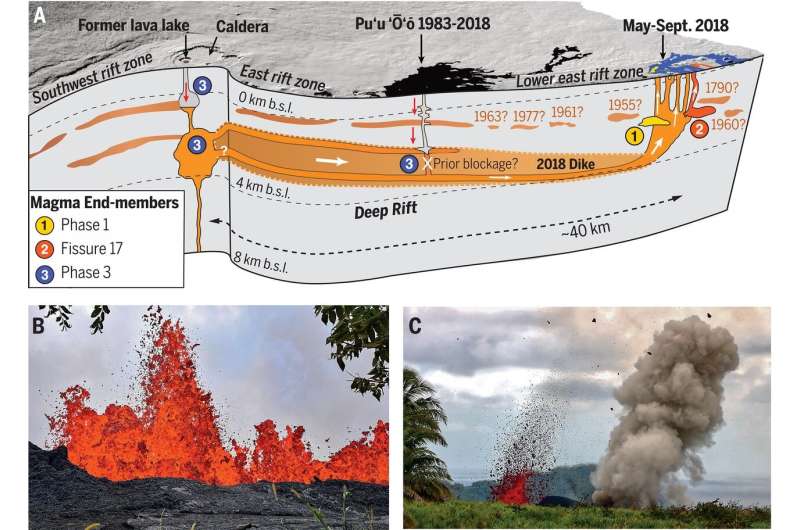December 6, 2019 report
Three studies describe different parts of the 2018 K墨lauea caldera collapse

Three separate teams working independently have learned more about what happens during a slow-moving volcanic caldera collapse by studying the 2018 K墨lauea eruption in Hawaii. Each has published their findings in the journal Science. Freysteinn Sigmundsson with the University of Iceland has published a in the same journal issue giving an overview of caldera collapse, and outlining the work by the three teams.
Caldera collapse occurs when the crater formed after a volcanic eruption collapses down into the ground below it. In the case of the K墨lauea eruption, the collapse involved drainage of the lava lake that was sitting in its crater鈥攎any described it as looking like a bucket of water draining into a hole in its bottom. Some calderas collapse quickly, while others collapse slowly. In the case of the K墨lauea eruption, the collapse occurred over a three-month span, giving scientists ample time to study it in detail.
All three studies were carried out by researchers from institutions across the U.S. and two in Japan鈥攊n the first, a group from the U.S. Geological Survey reported that the eruption led to the collapse and not the other way around, as some had suggested. They also found that it took surprisingly little released magma during the initial stages of the collapse to instigate the larger collapse that followed鈥攋ust 3.5 to 4 percent of the magma in the lava lake.
A second team from the University of Hawaii, with assistance from the U.S. Geological Survey, found that pockets of different types of magma from the collapse helped build what they describe as an advancing dike that played a role in the formation of a new underground system. They also found that sensor data could be used to forecast the appearance of hotter magma flows as they shifted from slower-moving, highly-viscous flows鈥攁 find that could prove useful for advanced warnings near similar volcanoes in the future.
The third team, with members from the U.S. Geological Survey, Hiroshima University and Kanazawa University found that swiftly moving magma surges far from the caldera had ties to changes in pressure from the collapsing caldera鈥攖hough longer-term changes were more closely related to the amount of magma that was drained from the caldera.
More information: Cheryl Gansecki et al. The tangled tale of K墨lauea's 2018 eruption as told by geochemical monitoring, Science (2019).
M. R. Patrick et al. Cyclic lava effusion during the 2018 eruption of K墨lauea Volcano, Science (2019).
Kyle R. Anderson et al. Magma reservoir failure and the onset of caldera collapse at K墨lauea Volcano in 2018, Science (2019).
Journal information: Science
漏 2019 Science X Network



















